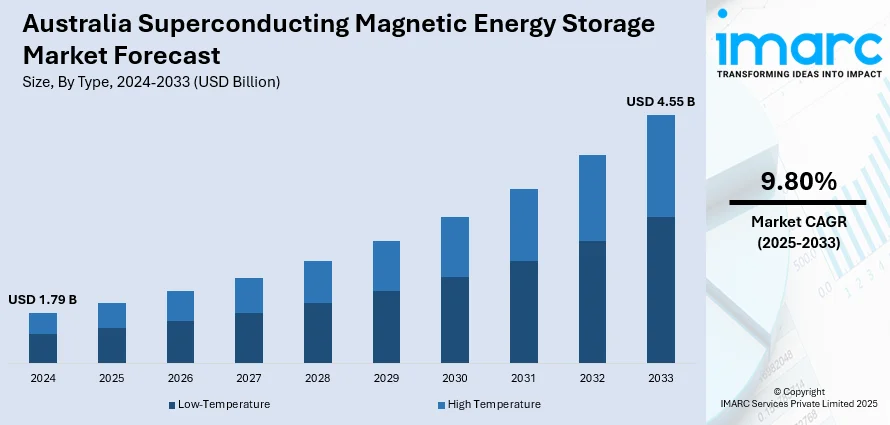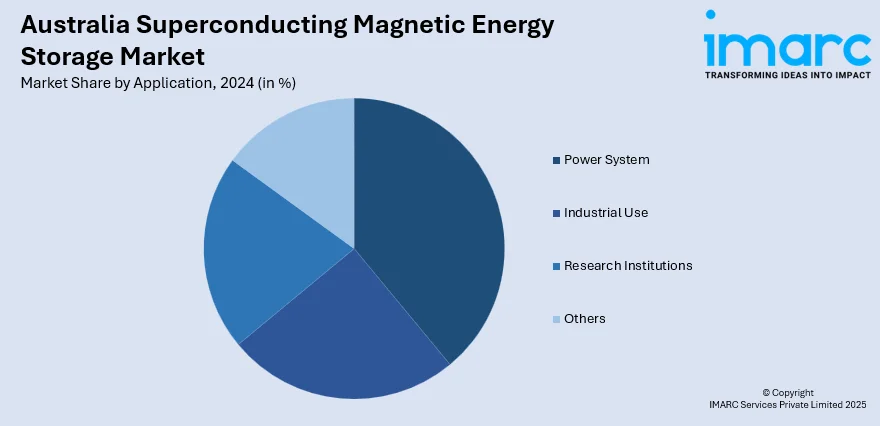
Australia Superconducting Magnetic Energy Storage Market Size, Share, Trends and Forecast by Type, Component, Application, and Region, 2025-2033
Australia Superconducting Magnetic Energy Storage Market Overview:
The Australia superconducting magnetic energy storage market size reached USD 1.79 Billion in 2024. Looking forward, IMARC Group expects the market to reach USD 4.55 Billion by 2033, exhibiting a growth rate (CAGR) of 9.80% during 2025-2033. The market is driven by increasing demand for grid stability, integration of renewable energy sources, and advancements in cryogenic and superconducting technologies. Government initiatives to modernize power infrastructure and reduce carbon emissions further support market growth. Rising concerns over energy efficiency and system reliability are also key factors boosting adoption of SMES solutions. These trends collectively contribute to the expanding Australia superconducting magnetic energy storage market share.
|
Report Attribute
|
Key Statistics
|
|---|---|
|
Base Year
|
2024
|
|
Forecast Years
|
2025-2033
|
|
Historical Years
|
2019-2024
|
| Market Size in 2024 | USD 1.79 Billion |
| Market Forecast in 2033 | USD 4.55 Billion |
| Market Growth Rate 2025-2033 | 9.80% |
Australia Superconducting Magnetic Energy Storage Market Trends:
Integration with Smart Grids and Renewable Energy
Australia's transition to renewable energy, like solar and wind, has raised the need for efficient energy storage. Superconducting Magnetic Energy Storage (SMES) systems are being incorporated in smart grids to stabilize the grid, regulate fluctuations, and provide constant power. SMES can efficiently supplement the variable output of renewable energy sources due to their quick response times and high efficiency, making them crucial for grid stabilization. These systems also offer essential services such as voltage regulation, frequency control, and enhanced demand response. In 2024, Australia pledged to install 4,029 MW of new energy storage capacity, including 11,348 MWh of storage, which highlights the nation's robust investment in large-scale energy storage solutions. This commitment is in line with Australia's pursuit of decreasing carbon emissions and improving the stability and sustainability of its power grid to facilitate the transition to a cleaner energy future.

To get more information on this market, Request Sample
Advancements in Superconducting Materials
Ongoing research and development (R&Dd) of superconducting materials continue to greatly enhance the performance and efficiency of SMES systems. Scientists are putting efforts into increasing low-temperature superconducting materials' energy densities and longevity. All these advancements will make SMES systems more economical and feasible to deploy in diverse uses, ranging from grid stability to powering charging stations for electric vehicles. These advancements in Australia are assisting in managing the increasing requirement for clean and reliable energy storage solutions. As the technology is advancing, SMES is being increasingly considered to fulfill energy requirements while minimizing environmental footprint, further strengthening the Australia superconducting magnetic energy storage market growth. Moreover, government initiatives supporting clean energy transition and increased investments in energy infrastructure are accelerating SMES adoption. Collaborations between research institutions and industry players are also fostering innovation, creating new opportunities in both urban and remote applications across the country.
Expansion of Electric Vehicle Charging Infrastructure
Electric cars (EVs) are becoming more and more popular in Australia, which is driving up demand for dependable and effective charging infrastructure. Superconducting Magnetic Energy Storage (SMES) systems are being explored as a way to provide rapid, reliable power to EV charging stations, especially during periods of high demand. By storing energy and rapidly discharging it, SMES ensures uninterrupted and seamless EV charging while reducing grid stress. This technology enhances the mass adoption of electric cars and supports Australia's sustainability ambitions by providing a stable power supply. By mid-2024, Australia had 1, 059 high-power public charging sites, an increase of 90% from the previous year. Combining SMES with EV infrastructure can further facilitate this growth by providing a cleaner, more efficient transportation system and assisting Australia in becoming a sustainable energy future.
Australia Superconducting Magnetic Energy Storage Market Segmentation:
IMARC Group provides an analysis of the key trends in each segment of the market, along with forecasts at the country and regional levels for 2025-2033. Our report has categorized the market based on type, component, and application.
Type Insights:
- Low-Temperature
- High Temperature
The report has provided a detailed breakup and analysis of the market based on the type. This includes low-temperature and high temperature.
Component Insights:
- Superconducting Coil
- Power Conditioning System (PCS)
- Cryogenics System
- Control and Monitoring System
A detailed breakup and analysis of the market based on the component have also been provided in the report. This includes superconducting coil, power conditioning system (PCS), cryogenics system, and control and monitoring system.
Application Insights:

- Power System
- Industrial Use
- Research Institutions
- Others
The report has provided a detailed breakup and analysis of the market based on the application. This includes power system, industrial use, research institutions, and others.
Regional Insights:
- Australia Capital Territory & New South Wales
- Victoria & Tasmania
- Queensland
- Northern Territory & Southern Australia
- Western Australia
The report has also provided a comprehensive analysis of all the major regional markets, which include Australia Capital Territory & New South Wales, Victoria & Tasmania, Queensland, Northern Territory & Southern Australia, and Western Australia.
Competitive Landscape:
The market research report has also provided a comprehensive analysis of the competitive landscape. Competitive analysis such as market structure, key player positioning, top winning strategies, competitive dashboard, and company evaluation quadrant has been covered in the report. Also, detailed profiles of all major companies have been provided.
Australia Superconducting Magnetic Energy Storage Market News:
- In October 2024, Australia been confirmed as a worldwide partner on the Long Duration Storage Shot effort by the US Department of Energy (DOE). The partnership aims to enhance collaboration on energy technologies, including energy storage and solar PV supply chains. This declaration came after US Secretary of Energy Jennifer Granholm and Australia's Minister for Climate Change and Energy, Chris Bowen, met in Brazil and emphasized their common objectives for the growth of sustainable energy.
- In September 2024, In the Northern Territory, Australia plans to construct SunCable, the biggest solar power facility in the world. Three million households in Australia will be powered by its six gigawatt capacity, which will also export energy to Singapore over a 4,500-kilometer submarine cable. Estimated at $22 billion, the project aims to drive Australia’s energy transition, reduce emissions, and create jobs. With power generating scheduled for 2030, construction is anticipated to start in 2027.
Australia Superconducting Magnetic Energy Storage Market Report Coverage:
| Report Features | Details |
|---|---|
| Base Year of the Analysis | 2024 |
| Historical Period | 2019-2024 |
| Forecast Period | 2025-2033 |
| Units | Billion USD |
| Scope of the Report |
Exploration of Historical Trends and Market Outlook, Industry Catalysts and Challenges, Segment-Wise Historical and Future Market Assessment:
|
| Types Covered | Low-Temperature, High Temperature |
| Components Covered | Superconducting Coil, Power Conditioning System (PCS), Cryogenics System, Control and Monitoring System |
| Applications Covered | Power System, Industrial Use, Research Institutions, Others |
| Regions Covered | Australia Capital Territory & New South Wales, Victoria & Tasmania, Queensland, Northern Territory & Southern Australia, Western Australia |
| Customization Scope | 10% Free Customization |
| Post-Sale Analyst Support | 10-12 Weeks |
| Delivery Format | PDF and Excel through Email (We can also provide the editable version of the report in PPT/Word format on special request) |
Key Questions Answered in This Report:
- How has the Australia superconducting magnetic energy storage market performed so far and how will it perform in the coming years?
- What is the breakup of the Australia superconducting magnetic energy storage market on the basis of type?
- What is the breakup of the Australia superconducting magnetic energy storage market on the basis of component?
- What is the breakup of the Australia superconducting magnetic energy storage market on the basis of application?
- What is the breakup of the Australia superconducting magnetic energy storage market on the basis of region?
- What are the various stages in the value chain of the Australia superconducting magnetic energy storage market?
- What are the key driving factors and challenges in the Australia superconducting magnetic energy storage?
- What is the structure of the Australia superconducting magnetic energy storage market and who are the key players?
- What is the degree of competition in the Australia superconducting magnetic energy storage market?
Key Benefits for Stakeholders:
- IMARC’s industry report offers a comprehensive quantitative analysis of various market segments, historical and current market trends, market forecasts, and dynamics of the Australia superconducting magnetic energy storage market from 2019-2033.
- The research report provides the latest information on the market drivers, challenges, and opportunities in the Australia superconducting magnetic energy storage market.
- Porter's five forces analysis assist stakeholders in assessing the impact of new entrants, competitive rivalry, supplier power, buyer power, and the threat of substitution. It helps stakeholders to analyze the level of competition within the Australia superconducting magnetic energy storage industry and its attractiveness.
- Competitive landscape allows stakeholders to understand their competitive environment and provides an insight into the current positions of key players in the market.
Need more help?
- Speak to our experienced analysts for insights on the current market scenarios.
- Include additional segments and countries to customize the report as per your requirement.
- Gain an unparalleled competitive advantage in your domain by understanding how to utilize the report and positively impacting your operations and revenue.
- For further assistance, please connect with our analysts.
 Request Customization
Request Customization
 Speak to an Analyst
Speak to an Analyst
 Request Brochure
Request Brochure
 Inquire Before Buying
Inquire Before Buying




.webp)




.webp)












